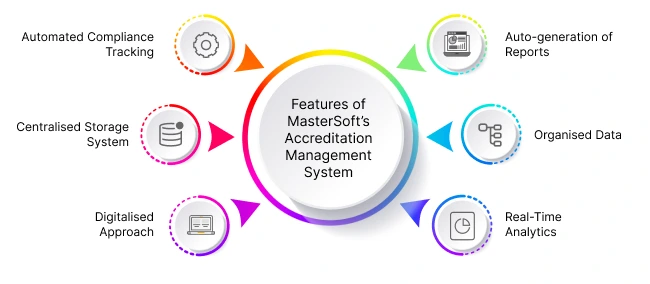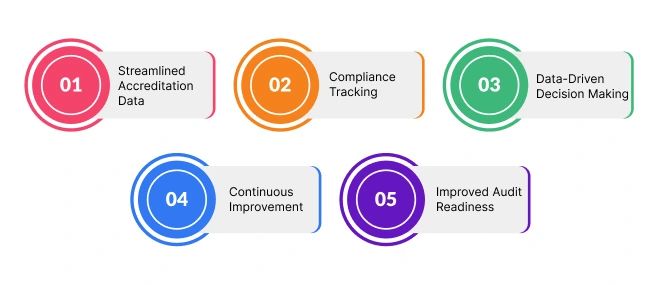23, Sept 2024
Maintaining a balance between quality education and institutional efficiency requires consistency and self-evaluation. A set of measures that guide institutes to implement the necessary changes to facilitate best practices has always been instrumental.
That is why institutes strive to get accreditation from major authoritative education boards such as NAAB/NAAC. However, it is a complex process involving an elaborate evaluation of institutes, courses, and programs. Manually executing the many-fold process is time-consuming, whereas using accreditation management software can streamline it effectively.
But what is accreditation, and why is it essential for institutes to get accredited? Let us have a look:
What is accreditation?
Accreditation is a systematic process wherein an institute undergoes a comprehensive evaluation, helping to ensure program effectiveness. It includes various steps that assess various areas, such as academic rigour, student support services, and institutional governance.
Furthermore, it is not a one-time event and requires institutes to demonstrate continuous improvement and commitment, ensuring high standards. It includes submitting institutional documents such as curriculum, faculty performance reports, student records, financial statements, etc.
Hence, it is an intensive and time-consuming task, and relying on manual mechanisms only increases the administrative workload. The solution lies in an advanced tool like MasterSoft’s accreditation management software that helps to complete the prerequisite formalities effectively. Besides, the system’s built-in features simplify the process.

Features of MasterSoft’s Accreditation Management System
Auto-generation of Reports
In-depth reports that indicate the quality of the overall institutional functions are significant documents that colleges must submit. The software auto-generates specific reports, such as the self-study reports, which pinpoint the strengths, weaknesses, and improvement areas.
Institutes can obtain compliance reports that showcase their adherence to the standards or criteria that the accrediting bodies have put in place. On the other hand, the progress reports an institute's achievements or journey towards accreditation goals and objectives.
What’s more, the system allows users to create customised reports, depending on their preferred criteria. For example, they can develop reports on faculty qualifications, financial data, and student learning outcomes.
Organised Data
A considerable amount of time and effort goes into creating, collecting, and organising data in paper-based or manual methods. In contrast, using the software enables institutes to complete the activity in half the time and eliminates work overload.
As a result, when institute team members enter data and reports, the system arranges them in chronological order. Also, it has control features, allowing users to track the changes made in the documents and data accordingly.
In effect, it maintains a digitalised history of the accreditation process, enabling institute management to get up-to-date information. Moreover, it maintains a chronological order of the data, helping to streamline four to five years' worth of information.
Real-Time Analytics
Does the data reflect personal bias or a lack of objectivity? Does the accreditation documentation include any redundant data? Finding answers to such questions is crucial, especially because it leads to identifying recurrent issues and inconsistencies.
Fortunately, accreditation management software has a real-time analytics dashboard, enabling institutes to determine potential issues. Furthermore, it provides a transparent overview of the entire accreditation process, providing accountability and compliance with standards.
They can obtain a graphical insight into the set goals and future objectives and track institutes’ gradual progress towards them. Also, it provides real-time data, allowing institutes to make informed decisions for different institutional functions.
Types Of Accreditation In India: What They Mean And Why They Matter?
Automated Compliance Tracking
Developing and implementing changes is hardly sufficient if institutes don’t monitor their ongoing progress. That is why aligning performance metrics to specific rubrics such as NABCB and NABL is crucial, as it ensures that documents match the standards.
Besides, institutes can leverage the software, which automatically monitors the continuous progress as per the accreditation standards. What’s more, it identifies areas lacking policy compliance; therefore, they can take corrective measures accordingly.
Institutes can obtain various reports, including gap analysis, compliance summaries, and trend reports, which provide insights into institutional performance as per standards. Also, they can modify the final documents after making appropriate changes as per the criteria.
Centralised Storage System
Institute team members can reduce manual data collection and storage as the accreditation data management system stores all information in a centralised location. In effect, institute team members can track comprehensive data and analytics.
Moreover, all authorised stakeholders can access the system, helping to collaborate and communicate effectively. For instance, the accounts and admin departments can work together to prepare the audits, depending on the centralised documents.
On the other hand, integrating the student information system helps merge student activity-related accurate reports into the accreditation data.
Digitalised Approach
Digitising the accreditation process enables institutes to eliminate the time-consuming paper-based processes. It automates document submission and review, reducing manual effort and increasing efficiency.
Thanks to digital platforms, institutes can maintain a continuous communication system with the accreditation body. Institute team members can have online meetings to discuss strategies, recent developments, etc.
Furthermore, the system creates audit trails, which help institute members track all the core activities, elevating the transparency and accountability quotient. Also, it reduces reliance on paper-based or manual operations and travel for in-person meetings.

Benefits of Accreditation Management System
Streamlined Accreditation Data
The system streamlines accreditation data in a centralised location, enabling institutes to manage and access crucial information effortlessly. Therefore, stakeholders can retrieve data easily as per the requirement.
Compliance Tracking
The software facilitates real-time monitoring of an institute’s progress as per the set standards. Also, it identifies the compliance-lacking areas.
Data-Driven Decision Making
The system generates various reports, such as compliance summaries, trend reports, and gap analyses, providing insights into institutional operations. Hence, they make data-driven decisions to overcome inefficiencies.
NAAC Accreditation: Guide to National Assessment and Accreditation Council (NAAC) for Higher Education
Continuous Improvement
The system’s centralised repository makes it easy for stakeholders to access and review relevant information, including policies, procedures, audit reports, and corrective action plans.
It alerts relevant personnel when it detects non-compliance, allowing for timely corrective action. Additionally, it tracks and analyses the accreditation-related KPIs (Key Performance Indicators), helping to identify areas of improvement.
Improved Audit Readiness
The software provides easy access to essential documentation and evidence, preparing institutes for accreditation readiness. As a result, institutes can identify and address compliance issues early on, helping to reduce or prevent potential risks of non-compliance.
Conclusion
MasterSoft’s accreditation data management is advanced software that optimises several crucial tasks. It automates core administrative activities, helping to reduce manual efforts and increase productivity.
Besides, it elevates the overall operational efficiency and improves the overall accreditation process through data analytics.
Want to enhance students’ thinking abilities but don’t know where to start? Learn More
Mobile: 08448010216
Email: janki.somani@iitms.co.in













